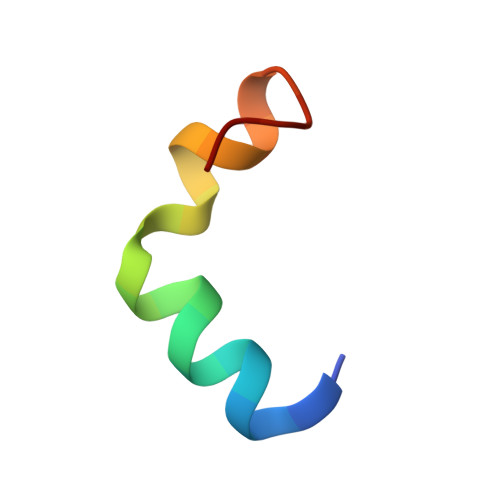Insights into conformation and membrane interactions of the acyclic and dicarba-bridged brevinin-1BYa antimicrobial peptides.
Timmons, P.B., O'Flynn, D., Conlon, J.M., Hewage, C.M.(2019) Eur Biophys J 48: 701-710
- PubMed: 31515575
- DOI: https://doi.org/10.1007/s00249-019-01395-y
- Primary Citation of Related Structures:
6G4V, 6G4X, 6R95, 6R96 - PubMed Abstract:
Brevinin-1BYa is a 24-amino acid residue host-defense peptide, first isolated from skin secretions of the foothill yellow-legged frog Rana boylii. The peptide is of interest, as it shows broad-spectrum antimicrobial activity, and is particularly effective against opportunistic yeast pathogens. Its potential for clinical use, however, is hindered by its latent haemolytic activity. The structures of two analogues, the less haemolytic [C18S,C24S]brevinin-1BYa and the more potent cis-dicarba-brevinin-1BYa, were investigated in various solution and membrane-mimicking environments by [Formula: see text] spectroscopy and molecular modelling techniques. Neither peptide possesses a secondary structure in aqueous solution. In both the membrane-mimicking sodium dodecyl sulphate micelles and 33% 2,2,2-trifluoroethanol ([Formula: see text] solvent mixture, the peptides' structures are characterised by two [Formula: see text]-helices connected by a flexible hinge located at the [Formula: see text] residues. With the aid of molecular dynamics simulations and paramagnetic probes, it was determined that the peptides' helical segments lie parallel to the micellar surface, with their hydrophobic residues facing towards the micelle core and the hydrophilic residues pointing outwards, suggesting that both peptides exert their biological activity by a non-pore-forming mechanism. Unlike that of the dicarba analogue, the C-terminus of the acyclic peptide is only weakly associated with the micellar surface and is in direct contact with the surrounding aqueous solvent.
Organizational Affiliation:
UCD School of Biomolecular and Biomedical Science, UCD Centre for Synthesis and Chemical Biology, UCD Conway Institute, University College Dublin, Dublin 4, Ireland.














